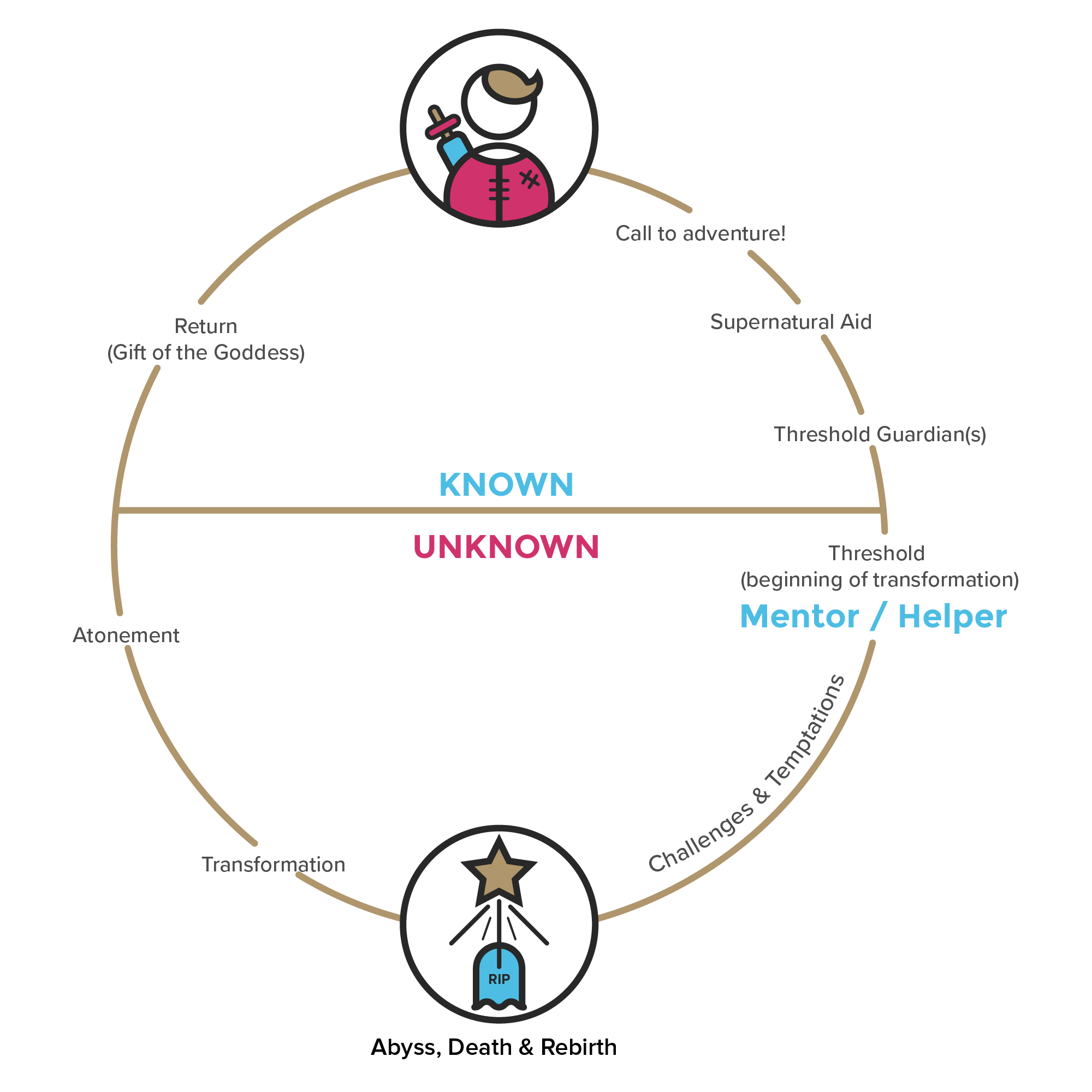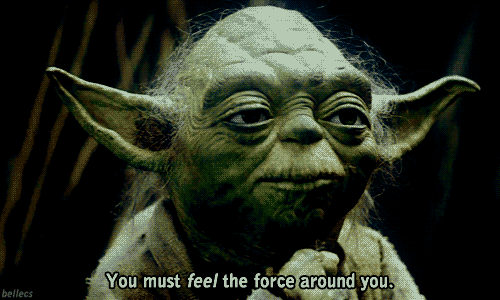“The world doesn’t revolve around you.”
Too many brands make themselves the hero of the story.
By being too involved in their own story instead of telling the customer’s story, these companies end up shooting themselves in the foot and missing valuable engagement opportunities with quality customers.
Whether you sell software or paper, B2B or B2C, large-scale or small, this holds true: your customer is the hero.
Your hero is on a personal journey, and they need your help—or rather, you need them to need your help.
A wise marketer once said, “everyone has the power within to be who they want to be. They simply need a guide to show them the path to getting there.”
That guide is your brand—and your task is to help the hero make his life better by selling him the tools he needs to succeed.
It all starts with the hero’s journey, a narrative pattern consisting of the basic stages of a quest that almost every hero goes through.

This cycle matches up roughly with another journey that your customer is on—that of a buyer.
Aligning the stages of both journeys helps us to see how our hero, our customer, is thinking about your brand. It also helps you, as the mentor, to identify what help is needed and when.
The Buyer’s Journey
- Awareness stage = call to adventure
The customer realizes they have a problem that needs solving.
Just like how encountering problems disrupts our everyday lives, being called to an adventure disrupts the ordinary life of the hero.
Neither can deny that there is now an issue that needs resolving, and neither can go back to normal until it is settled.
- Consideration stage = challenges and temptations
The customer defines the problem and researches the different possible solutions.
The hero finds himself head-to-head with varying obstacles, but in the end, they serve to help him more clearly envision the true goal that awaits.
In both circumstances, the protagonist pushes onward with a clearer picture of what lies ahead.
- Decision stage = reward
The customer lands on the perfect solution to the problem, likely with some guidance from you on which tool is the best fit for the customer’s needs based on his unique situation.
Meanwhile, the hero receives her reward for going through the long and difficult journey.
Of course, it wouldn’t have been possible without the hero’s mentor, guiding the protagonist to the best possible outcome.
So you have a hero, you have a problem or quest that needs resolving, and you are tasked with the very important role of being the guide.
How do you succeed?
How to Be the Mentor in Your Hero’s Journey
Here are my 10 tips for truly empowering your customer and better marketing your business.

The hero’s journey is about the hero, not the side characters
It’s always tempting to talk all about your brand: how long the company has been in business, any awards you received, the quality of the products or services, etc.
Don’t do it. Focus on them, not yourself.
The customer should be the star of the show; don’t turn them into a minor character.
Besides, people tend to self-identify as the hero anyway, so to go against that internal belief is to disregard the importance of your customer’s personal journey—and to almost completely guarantee that the customer will tune out the rest.
Your brand should play a supporting role: understand the story the customer is living and identify the role your business needs to play within it to help her succeed.

Know the one thing your customer wants
Identify the number one thing that people want, not the top 50.
A much more effective approach to proving your value is by anticipating the customer’s exact needs, not by telling a story about how smart and successful you are—and that you’re so good at what you do, you’ll tackle all the problems, big or small.
That’s not what a customer needs; they’re thinking of only the most important problem that requires a solution.
Once you identify that one need that the customer is trying to fulfill, you need to craft your messaging around it to be clear, memorable, and compelling enough to inspire a purchase.
Remember, your role as the mentor is to empower your customers on their journey, so honor their journey and the struggles of the audience as a whole by giving (read: selling) them the tools they need for success.
Knowing precisely what those tools will be is a sign of a good mentor. Speaking of which...

Be a good mentor for your hero
Heroes won’t follow a guide that proves to be inadequate, which is why you need to have the right balance of empathy and authority.
Without understanding the feelings that the customer is feeling, you don’t stand a chance of identifying their pain points and helping them make decisions based on those.
If you can’t connect an emotionally-driven need to your solution, why would people buy it?
The solution absolutely must target something that lights a spark in the customer and results in an inner voice saying, “I need this.” Not simply “I want this.”
The mentor needs to be competent, of course, but there’s a fine balance with authority: too little and you’re not actually guiding the hero; too much and you’re dictating what they should do.
People hate being told what to do.
The guide’s role, therefore, is to gently push the hero in the right direction—enough that the hero thinks it’s (at least partially) her idea and is successfully swayed.
It’s all about the plan, too: think back to the hero’s journey at the beginning of this article...and notice how early in the cycle the mentor chips in and takes the reigns.
Without Yoda, Luke would likely fail.
Not because Luke didn’t have what it takes to be the hero, but because Yoda had the knowledge, empathy, and strict Jedi training plan to help Luke rise up to his potential.
Similarly, you can walk your customer through the plan of how the tools you provide them will lead to success.
Finally, a good mentor is always there for his hero. You must be there the whole time that they need you, not only when it’s convenient for you.
As harsh as this may sound, the hero only cares about how your product or service can help improve her life and nothing more, so cut out the salesy fluff that doesn’t apply.

Focus on the customer’s needs instead of your profit margins
It seems obvious, but it’s worth mentioning anyway.
Even if, deep down, you truly put the customer’s needs before your business’s, you still need to show it; actions speak louder than words.
How can you prove yourself to these heroes?
First, craft messaging that showcases how your brand exists to serve the customer: something along the lines of, “it’s not about us; it’s about you” should be the overarching theme.
Then there’s your brand’s story: while it’s tempting to spout off a list of accomplishments and say things that make you sound official and successful, your brand story should answer the question of why you care about the customer.
By reversing the message to focus on how the company serves its heroes rather than itself, customers will trust that you have their best interests in mind.
Content marketing is your best bet for proving to your customers that solving their problems is your focus.
Utilize the platforms for engagement that you have by answering customer questions, providing helpful or education content, and even suggest a specific solution to customers who seem lost.
Careful though, as you don’t want to be too authoritative with the last part—remember to gently guide them to a solution so that they aren’t tempted to run the other way instead.
Tackle all the problems in one go
There are three types of problems in a story: the external, internal, and philosophical.
The external problem is the physical problem.
In the classic case of Star Wars, the external problem was that, with the Death Star as their ultimate weapon, the Dark Side was on track to take over the galaxy.
The internal problem is the way it makes the character feel.
Again with the Star Wars example, Luke felt in his heart that it would be wrong for the Dark Side to win and took it upon himself to save the day.
The philosophical problem addresses why it is wrong.
The Dark Side’s thirst for power is not justified in a world where “good” and “evil” are separated into “acceptable” and “unacceptable;” therefore, it would be unacceptable to let the Dark Side win.
This may seem like it’s veering away from businesses dealing with customers, but it’s not.
Most often, companies sell solutions to external problems while humans buy solutions to internal problems, leaving some disconnect between the two.
It’s like selling someone on the idea that buying a new vacuum will make their house look cleaner, therefore solving the problem of filth, when really, the customer has a deep fear of being perceived as less sophisticated and successful among peers because their house is embarrassingly messy and dusty.
A good mentor, therefore, must be acute to these subtle differences in the source of the hero’s problem in order to properly appeal to her motives and help her succeed.
If you can sell something while targeting all three of these types of problems, you can sell anything.

Tell customers what their success and failure will look like
Nothing motivates a person more than the threat of failure and knowing what they will miss out on.
A good guide will show his hero both sides of the coin so that the hero is fully aware of all possible consequences.
Similarly, customers may be more inclined to buy if they are made aware of the aftermath of failing.
This can be difficult to relay in a non-cautionary tale-sounding way, but you can get creative here.
For instance, using statistical data to paint a picture of how website traffic can be negatively affected (ie. plummet) by poor SEO—and how it can spike when your site is properly optimized - would be a great way to guide a customer toward buying SEO services from your agency.
Simply telling them “this is important. You need it...or else” doesn’t quite cut it.

Use proof from past heroes to help future heroes succeed
Case studies and testimonials from real customers will go a much longer way than simply boasting about your brand’s credentials.
As I mentioned in my article full of statistics about millennials, 95% of them believe friends (and peers) are the most credible source of product information. Consider also that 88% of all consumers trust reviews when making a purchase.
Why not use that to your advantage?
Showing the potential customer pure facts and unbiased reviews will be more convincing than your best elevator pitch.
Also, stick to the truth.
Never, ever lie and manipulate a hero just to get them to purchase, as it could ruin your reputation over a customer that wasn’t a good fit for your brand anyway.
Instead, actually help your potential customers succeed: show them what is possible with your help by allowing your heroes to preview their reward—even if for just a moment.
Much like how Yoda shows off his Jedi skills to Luke to show him the power he will gain, harness the power of testimonials and success stories to hype up your customers.

Marketing-wise, keep it simple
A photo of a person makes customers think of someone else—specifically, whoever is in the photo.
However, swap a realistic photo for a simple cartoon, and the customer can more easily relate to and place themselves in the image.
It’s funny how the brain works; take advantage of our human nature of relating to scenarios by keeping imagery as ambiguous and simple as possible.
On the hero side of the matter, many times, the mentor of the hero was once in his very shoes.
Have you noticed that, when that happens, the mentor always makes a point of bringing it up? Suddenly, success is so close and realistically attainable, the hero can almost taste it.
Imitate the feeling of being so close to the goal by allowing the customer to be able to clearly picture herself in the imagery of a happy and accomplished customer.
Finally, where you position your call-to-action, or CTA, can make a world of a difference.
You want your CTA in a place where customers will know that, by clicking that button, they’re about to resolve all their problems in once place.
Craft the copy to pinpoint all three types of problems as mentioned in tip #5 to get the best conversion rate.
Think of this as the door to the hero’s reward: what lies behind it will mark the end of their quest, which means they can finally rest easy.
And you too can rest easy, waiting for the next unexpected hero to wake up to a problem that needs your help to be solved.
I'll leave you with this: in order to truly succeed as a mentor for your hero...






